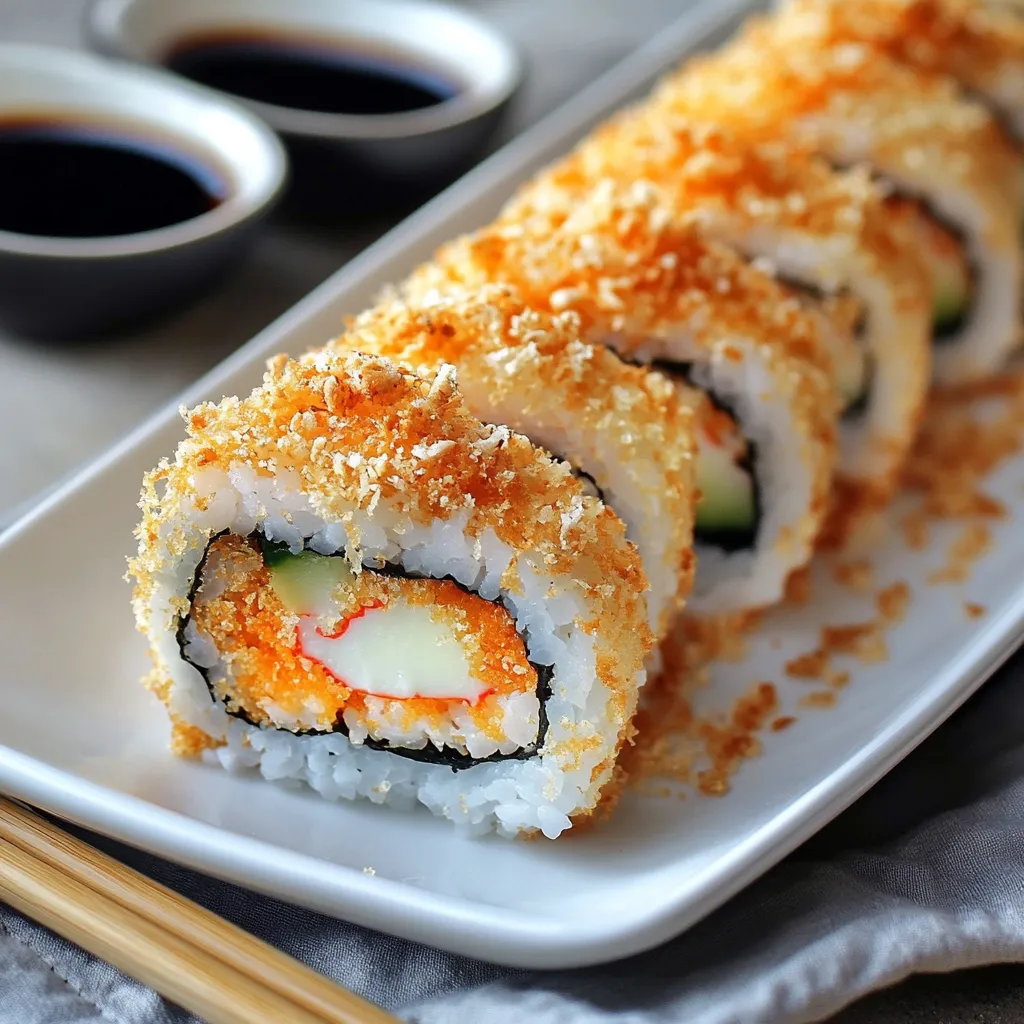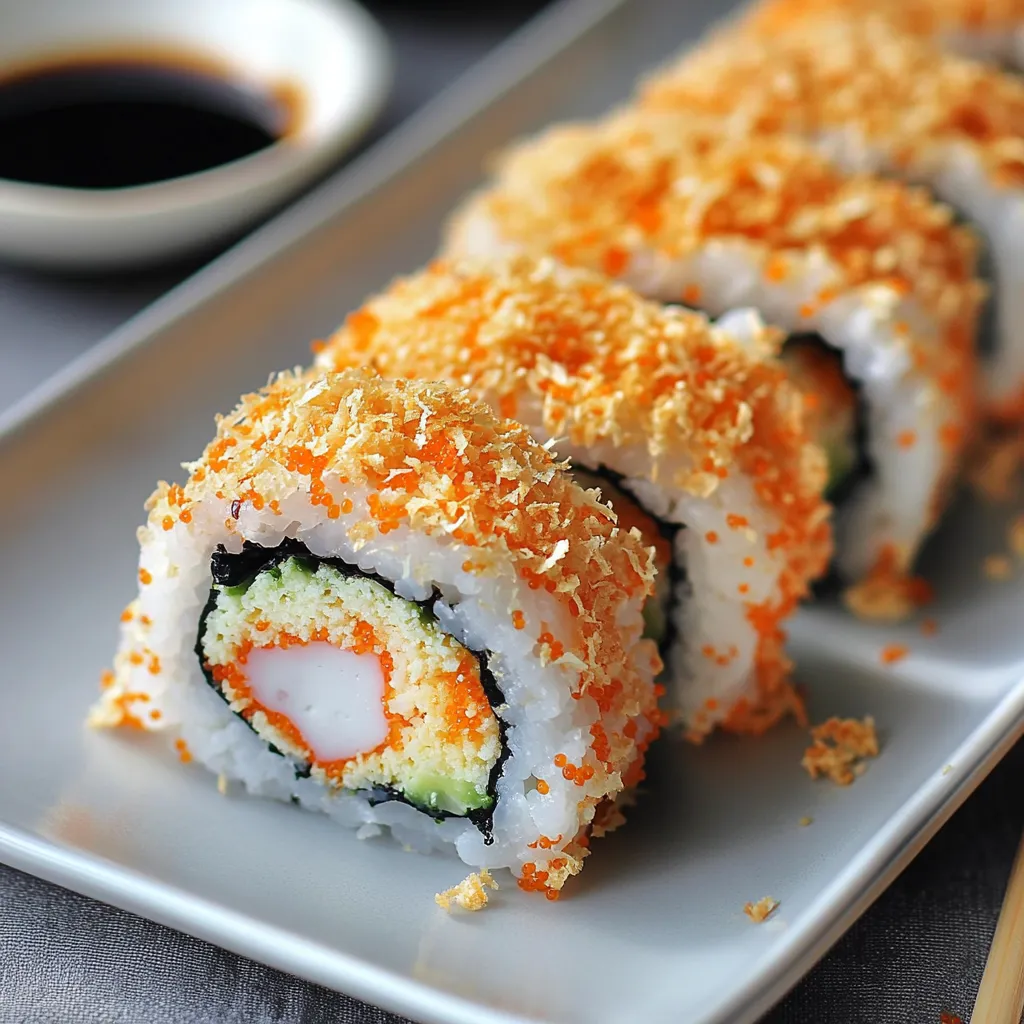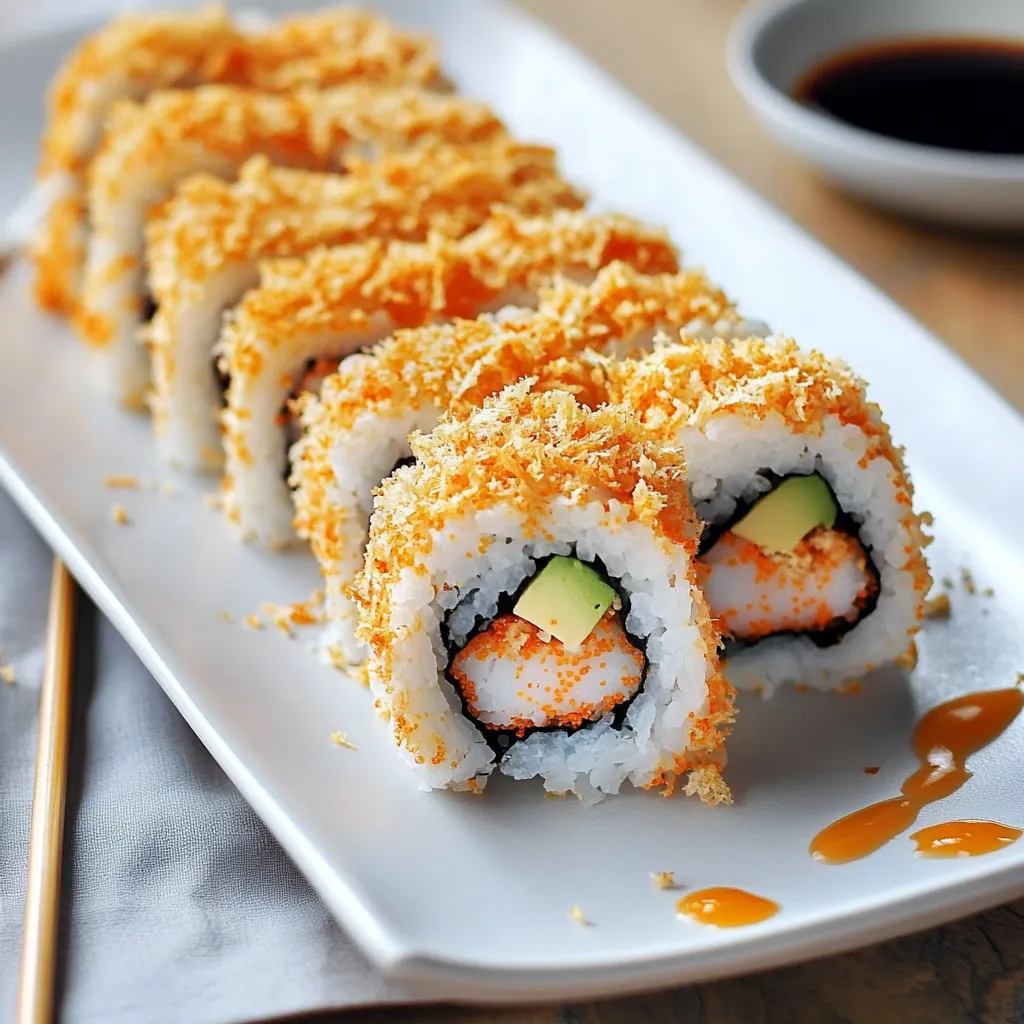 Pin it
Pin it
Imitation crab, creamy avocado, and crisp cucumber combine with perfectly seasoned rice and nori to create restaurant-worthy sushi in your home kitchen. This California crunch roll delivers the beloved flavors of classic sushi with satisfying textural contrast from crunchy toppings that elevate the experience. Creating these rolls yourself allows complete control over ingredients and freshness while developing skills that impress family and friends.
I discovered homemade sushi during a particularly ambitious weekend cooking project. What started as curiosity evolved into a monthly tradition where friends gather in my kitchen with various ingredients, creating personalized rolls. The laughter surrounding slightly imperfect rolls always reminds me that cooking together creates memories far more valuable than perfectly shaped food.
Essential Components
- Sushi rice: Provides the foundation with its subtle vinegar seasoning and sticky texture proper cooking and cooling ensures ideal consistency for easy rolling.
- Nori sheets: Create the classic wrapper with distinctive oceanic flavor and important structural support store tightly sealed for maximum freshness.
- Imitation crab: Offers sweet, mild seafood flavor and vibrant color contrast select higher quality surimi for better taste and texture.
Rolling Technique
- Rice Preparation:
- Lay plastic wrap across your clean work surface or bamboo mat creating a smooth foundation. Spread cooled sushi rice evenly into a thin rectangular layer using moistened fingers to prevent sticking. Cover with additional plastic wrap then gently compress with a rolling pin until approximately half-inch thickness throughout.
- Nori Placement:
- Remove the top plastic layer and position your nori sheet rough-side down directly onto the prepared rice. Trim any excess nori creating proportional dimensions that allow complete coverage and proper sealing when rolled.
- Filling Arrangement:
- Arrange your crab sticks, avocado slices, and cucumber strips in a neat line across the center of your assembly. Apply small amounts of spicy mayo and eel sauce directly onto fillings creating flavor integration throughout the roll.
- Proper Rolling:
- Grasp both sides of the bottom plastic wrap using your thumbs and forefingers, then lift upward bringing the entire edge toward the center. Continue rolling forward using gentle pressure to form a compact cylinder while keeping ingredients secure inside.
- Final Shaping:
- Utilize the bamboo mat or kitchen towel to apply even pressure along the entire roll, sealing edges completely. The final shape should display uniform thickness throughout its length ensuring consistent pieces when sliced.
- Topping Application:
- Squeeze decorative lines of spicy mayo and eel sauce across the roll's exterior surface. Sprinkle French fried onions generously along the top pressing gently to adhere while maintaining their crispness. Additional toppings like tobiko or sesame seeds can be applied before slicing.
 Pin it
Pin it
My daughter initially hesitated trying homemade sushi, convinced only restaurant versions would taste authentic. After helping construct her first California roll and customizing the spiciness level perfectly to her preference, she became our household's most enthusiastic sushi maker. Now she regularly invites friends over for sushi-making parties where creativity produces combinations we'd never find on restaurant menus.
Customization Magic
The California roll framework welcomes countless variations based on preferences and ingredient availability. Cream cheese introduces rich tanginess that pairs beautifully with the sweet crab and avocado elements. Mango slivers add tropical sweetness that brightens the overall flavor profile while maintaining textural harmony. Thinly sliced jalapeños introduce controlled heat that activates the palate without overwhelming more delicate components. Microgreens provide nutritional boost alongside visual appeal that transforms homemade rolls into restaurant-worthy presentations.
Storage Suggestions
While sushi ideally showcases its best qualities immediately after preparation, proper storage techniques maintain reasonable quality for limited periods. Wrap individual rolls tightly in plastic film before refrigerating to preserve moisture balance and prevent drying. Consume refrigerated sushi within twenty-four hours for optimal flavor and textural experience. Allow chilled sushi to sit at room temperature for ten minutes before serving to enhance flavor perception that becomes muted under refrigeration. Avoid freezing fully assembled sushi as textural degradation occurs upon thawing.
 Pin it
Pin it
Frequently Asked Questions
- → Do I need a special sushi mat to make these Homemade Sushi Rolls?
- While a bamboo sushi mat (makisu) is helpful, this recipe is designed to work without one. You can use plastic wrap and your hands or a kitchen towel to shape the rolls. The plastic wrap technique makes it easier for beginners to handle the sticky rice and form tight rolls.
- → What kind of rice should I use for these Homemade Sushi Rolls?
- Traditional sushi rice (short-grain Japanese rice) works best, but the recipe indicates you can also use brown rice as an alternative. The important thing is that the rice is properly cooked, seasoned with rice vinegar if desired, and cooled before using it to make your rolls.
- → Can I substitute ingredients in these Homemade Sushi Rolls?
- Absolutely! This sushi roll recipe is very versatile. You can substitute the imitation crab with cooked shrimp, salmon, tuna, or tofu for a vegetarian option. Feel free to add other fillings like carrots, bell peppers, or mango depending on your preferences.
- → How do I make spicy mayo for these sushi rolls?
- Spicy mayo is easy to make at home by combining 2 parts mayonnaise with 1 part sriracha sauce. Adjust the ratio based on your preferred level of spiciness. Mix well until smooth and creamy. Store any leftovers in the refrigerator for up to a week.
- → How long do these Homemade Sushi Rolls stay fresh?
- These sushi rolls are best enjoyed immediately after preparation. However, you can store them in the refrigerator, tightly wrapped in plastic wrap, for up to 24 hours. The rice will gradually harden when refrigerated, so bring them to room temperature for about 15-20 minutes before serving leftover rolls.
